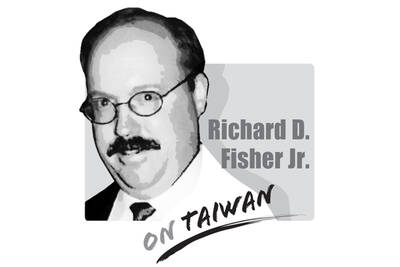The Chinese Communist Party’s (CCP) “united front” tactics continue to distort history to form a narrative conducive to CCP control over territories it lays claim to.
On Friday, the Council of Indigenous Peoples criticized former Chinese Nationalist Party (KMT) legislator Yosi Takun (孔文吉) for remarks he made during an event hosted by China’s Yunnan Minzu University. The remarks suggested that Taiwan’s indigenous people — who are of Austronesian descent, speak Austronesian languages, and have an independent identity and culture — are part of China’s minority cultures.
The council is right to push back against the obvious distortion targeting Austronesian people in Taiwan who have lived here for approximately 15,000 years.
The idea is so easily refutable that perhaps it is better to look behind the distortions and understand why the CCP is resorting to such unfounded claims.
The root of the problem is that the CCP is attempting to forge a nation state out of territory the Republic of China (ROC) inherited from the Manchu Qing Dynasty, which was subsequently transferred to the People’s Republic of China (PRC) when the CCP defeated the KMT in 1949, Chinese-Australian historian and Sinologist Wang Gungwu (王賡武) said.
The concept of the nation state developed in the late 18th century was formulated within the context of the majority of the countries in Europe already encompassing people who spoke the same language, had the same historical narrative and probably shared the same religion, and turning the people within the borders of each country into a nation state was relatively straightforward, Wang said.
Many Asian countries did not have this luxury, as their borders did not evolve along national lines, but were drawn according to the requirements of colonial masters, he said. Japan was one exception. China had a different quandary: The ROC in 1912 inherited the borders of the Manchu Qing empire, which was not a Han empire, but a Manchu-Mongol one, and covered territory beyond countries with majority Han Chinese populations.
Taiwan was not part of this territory: The Manchu-Qing empire had ceded it to Japan in 1895, and Japan did not relinquish control over Taiwan until 1945.
ROC founder Sun Yat-sen (孫逸仙) looked for a way to organize his inherited borders as a republic modeled on the two successful republics of the day, the US and France, to govern diverse groups of people who had been controlled by an imperial state. Wang called this a “mammoth task.”
The CCP is still struggling to work out how to control diverse groups who have never belonged to a nation in an ethnic — as opposed to political — sense, and to claim legitimacy for that project, Wang said.
If it fails to do so, it runs the risk of losing control over the territories it now controls through fragmentation along defined national, historical and ethnic lines, as happened in the late 20th century with the collapse of the Soviet Union, he said.
Putting all of these groups under the umbrella of the “Chinese nation” (中華民族), a term invented by Sun and co-opted by the CCP, is a solution, but ethnic groups and nations such as the Tibetans, Uighurs, Taiwanese and Austronesian indigenous groups in Taiwan are not buying it.
That is, the roots of the “united front” attempts to absorb Taiwan’s indigenous people into its orbit extend beyond the CCP’s fabricated claims over Taiwan; they strike at the heart of the CCP’s legitimacy and the party’s definition of the PRC as a nation state.

On Sept. 3 in Tiananmen Square, the Chinese Communist Party (CCP) and the People’s Liberation Army (PLA) rolled out a parade of new weapons in PLA service that threaten Taiwan — some of that Taiwan is addressing with added and new military investments and some of which it cannot, having to rely on the initiative of allies like the United States. The CCP’s goal of replacing US leadership on the global stage was advanced by the military parade, but also by China hosting in Tianjin an August 31-Sept. 1 summit of the Shanghai Cooperation Organization (SCO), which since 2001 has specialized
In an article published by the Harvard Kennedy School, renowned historian of modern China Rana Mitter used a structured question-and-answer format to deepen the understanding of the relationship between Taiwan and China. Mitter highlights the differences between the repressive and authoritarian People’s Republic of China and the vibrant democracy that exists in Taiwan, saying that Taiwan and China “have had an interconnected relationship that has been both close and contentious at times.” However, his description of the history — before and after 1945 — contains significant flaws. First, he writes that “Taiwan was always broadly regarded by the imperial dynasties of
The Chinese Communist Party (CCP) will stop at nothing to weaken Taiwan’s sovereignty, going as far as to create complete falsehoods. That the People’s Republic of China (PRC) has never ruled Taiwan is an objective fact. To refute this, Beijing has tried to assert “jurisdiction” over Taiwan, pointing to its military exercises around the nation as “proof.” That is an outright lie: If the PRC had jurisdiction over Taiwan, it could simply have issued decrees. Instead, it needs to perform a show of force around the nation to demonstrate its fantasy. Its actions prove the exact opposite of its assertions. A
A large part of the discourse about Taiwan as a sovereign, independent nation has centered on conventions of international law and international agreements between outside powers — such as between the US, UK, Russia, the Republic of China (ROC) and Japan at the end of World War II, and between the US and the People’s Republic of China (PRC) since recognition of the PRC as the sole representative of China at the UN. Internationally, the narrative on the PRC and Taiwan has changed considerably since the days of the first term of former president Chen Shui-bian (陳水扁) of the Democratic